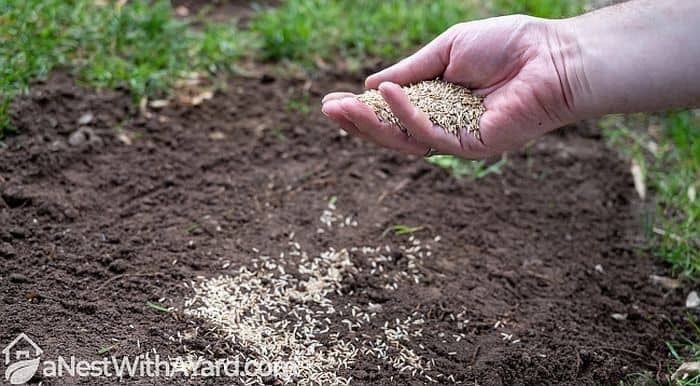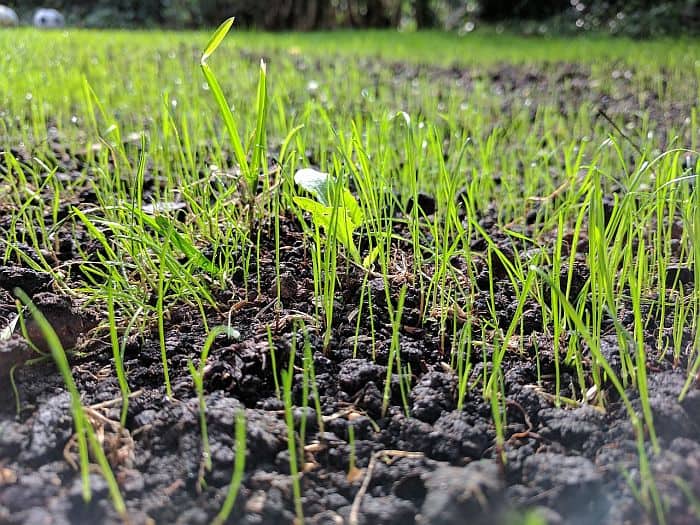[ad_1]
How long does it take to grow grass? It takes 5 to 30 days for grass seed to grow. The speed of germination mostly depends on the grass type. Both Zoysia grass and Kentucky bluegrass can sprout within 14 days, while Bermuda grass can germinate within 5 days!
Have you planted new grass on your patchy lawn? Can’t wait for the new grass seed to start coming in?
But how long will you have to wait for the young grass to appear? Not long! Grass seed germination usually takes between 5 to 14 days!
Of course, this is not always the case and the waiting period can be somewhat broad. The duration of germination will depend on the grass species, amongst other factors! Let’s find out what affects the grass growth and if you can speed it up to get a vibrant lawn quicker!
Grass Seed Germination: How Long Does It Take?
So, how long does it take for the new grass to start growing?
It depends on who you ask, really! Experts explain that grass seed can take anywhere from 5 to 30 days to start growing. But not to worry! You will most likely see new grass seedlings popping out of the soil 5 to 14 days after planting them.
Still, how come grass seed germinates at such different rates? This 5 to 30 day period is very broad if you think about it. Well, that’s because many different factors affect the time it takes for the seed to start sprouting.
Here are three main factors that influence the germination of grass seeds:
- Grass seed variety you have chosen to plant
- Time of the year you are planting
- Soil moisture
Let’s discuss the role of each factor separately!
Grass Variety: Cool Season Grass Vs Warm Season Grass

The speed of germination depends on the grass species. Different seeds germinate and grow at different rates. Some are known for their rapid growth, while others are naturally a bit “lazier.”
Let’s take a look at germination rates of some of the top lawn grasses used today, including cool-season grasses and warm-season grasses.
Cool-season grasses:
- Kentucky bluegrass: 14 to 30 days
- Perennial ryegrass: 5 to 14 days
- Annual ryegrass: 7 to 10 days
- Red fescue: 4 to 14 days
- Bentgrass: 5 to 7 days
Warm-season grasses:
- Zoysia grass: 14 to 21 days
- St. Augustine grass: 7 to 14 days
- Bermuda grass: 5 to 14 days
- Buffalo grass: 15 to 21 days
- Centipede grass: 14 to 28 days
You can now clearly see that every grass seed type has its own germination rate in ideal growing conditions. There is little to nothing you can do to change the speed of growth. You can only improve the soil quality and moisture content to create the best environment for the grass to grow in.
That said, producers of grass seed have found ways to optimize the growth of their products. Some manufacturers hull grass seeds before putting them on the market.
For instance, unhulled Bermuda grass takes 7 to 14 days to sprout, just like St. Augustine grass. If hulled, the germination period shortens to 5 to 10 days. Find out more on the similarities and differences between Bermuda vs St. Augustine.
A lot of companies nowadays also coat their seeds with chemicals. These keep the seed moist and make it more robust and ready to grow. The seed coating helps:
- Absorb and retain moisture in case you forget to water grass seeds.
- Feed the seeds with essential nutrients to help jump-start the sprouting.
- Protect grass seedlings against harmful diseases.
Grass seeds are sold separately or as a mixture of different grass types. Always look at the label on the bag to see how long a mixture of different seeds will take to sprout.
The Time Of Year: Planting Season

The time of year you plant grass seed plays a huge part in germination. Weather can greatly impact the germination of seeds and the growth of seedlings.
The general rule is you should avoid planting grass seed in winter. The seeds simply won’t germinate in cold soil and under cold weather conditions. You should wait for the soil temperatures to jump to at least 46 degrees Fahrenheit (8 degrees Celsius) to start sowing.
Avoid planting seeds too early in spring, as well. Don’t let those rising daytime temperatures deceive you. The soil can still be frosted, and the cool evenings can delay the germination for up to two weeks. While waiting for the temperature to rise, the seeds can get blown away or eaten by birds.
You shouldn’t plant your grass in the middle of summer either. Heat can inhibit the germination process due to the lack of moisture in the soil and the air.
So, when is the best time to plant your grass seed?
That depends on the grass type you are dealing with. Both warm-season grasses and cool-season grasses have their preferences. The seed bag should clearly state when the best time to plant grass is, especially if you have bought a combination seed mix, like this one .
Cool-season grass seed can be sown in mid-spring, unlike warm-season grass that prefers late spring. Cool-season grass stays green into late fall, right until temperatures drop. Warm-season grasses have a shorter life. They go dormant in early fall or mid-fall.
The first step to growing a perfect lawn is getting the right seed type for your local weather. Cool-season grass seed may appear more resilient than warm-season grass seed. They can tolerate cold winters but not so much during hot summers. Find out which grass is best for Florida weather!
Soil Conditions: Moisture

The moisture content of the soil also plays a vital part in seed sprouting. Plants need water to grow and thrive. Without adequate hydration, the seeds can’t germinate nor thrive.
Regular watering will start the germination process. That’s why you need to establish a reliable watering schedule. The soil should be kept moist at all times – not too dry or too wet. Remember, too much of a good thing can be a bad thing!
Keep the lawn moist with a healthy watering routine and a reliable sprinkling system that doesn’t form puddles and streams. Those can wash the seeds away and leave some of the areas of your existing lawn bald.
How You Can Speed Up Grass Seed Germination

Wouldn’t you want to make your grass grow faster?
Every gardener knows that growing grass from seed takes time, patience, and practice. There are things that affect the grass growth that you can control, and things that are out of your hands.
Generally speaking, you can’t speed up seed germination. But, you can learn how to improve growing conditions and potentially stimulate seed germination.
The best thing you can do is prepare your existing lawn for the new seed. You want to plant seeds in a healthy and rich bed of soil. Here is what’s you should do before planting grass seed:
- Eliminate weeds before planting grass seed.
- Sow grass seed in mid to late spring, early summer, or early autumn, when the soil temperature is above 55 degrees Fahrenheit and air temperature is above 60 degrees Fahrenheit.
- Aerate the soil or learn how to overseed your lawn without aerating.
- Mix manure or organic fertilizer into the soil. Check out my in-depth review of 10-10-10 fertilizer!
- Avoid sowing on windy days, otherwise, your seeds will get blown away.
- Buy high-quality seed and follow the planting instructions on the packaging.
- Water the site regularly and consistently until the seeds germinate. Keep the soil moist, but not wet! Never let the soil dry out!
- Plant the seeds by distributing them evenly on the ground and raking them. A thin layer of topsoil will protect the seed from heat and getting blown away.
- Remove any weeds that grow during the germination time as a part of your lawn care.
- Hold off on mowing your baby lawn until at least 2 to 3 weeks after sowing. Click here to learn when you should start mowing after overseeding.
Watch this video to learn how to plant grass seed the easy way:
How Often Do You Water New Grass Seed?
You should establish a reliable and consistent watering routine for your new seed. This may come as a surprise, but you will need to water your freshly planted lawn once a day, maybe twice, if the evaporation is rapid due to warmer temperatures.
You should water your lawn until it is wet six to eight inches deep before planting and three to four inches deep after planting to encourage the growth of deep roots. If you don’t water adequately, the seedlings will develop shallow roots and will have less of a chance of survival. Also, water in the mornings and evenings to minimize water loss and keep your water bill low.
You should keep up with this watering routine until the seeds germinate. Adjust your watering schedule based on the current weather. Water more during sunny days and skip it when it rains.
Click here to learn how to water grass seed and when to stop.
FAQs
Will Grass Seed Grow If I Just Throw It Down?
Grass seed will grow if you just throw it down on the ground. Still, it is better if you put a thin layer of soil or mulch on top. Lightly rake the seeds to cover them. The topsoil will keep the seeds from drying and getting washed away.
How Can I Speed Up The Growth Of Grass Seed?
You can speed up the growth of grass seed by watering and fertilizing the soil properly. Keep the soil consistently moist until the seeds sprout. Don’t plant seeds unless the soil temperature is at a consistent 55 degrees and air temperatures reach 60 degrees Fahrenheit.
How Long Does It Take Grass Seeds To Sprout?
How long it takes grass seeds to sprout depends on the grass species, weather, and soil moisture. Grass seed usually sprouts within 5 to 14 days or anywhere up to a month. After that, the grass keeps growing at a rate of 1 to 3 cm a week.
How Long Does Grass Seed Take To Grow Fully?
It takes 6 to 8 weeks for grass seed to grow fully. The seeds will germinate within 14 days if growing conditions are ideal. Once the new lawn is fully matured and developed, you can feel free to walk on it. Until then, avoid foot traffic.
Growing New Lawn Takes Time And Patience
Waiting for a new lawn to sprout can take anywhere from 5 days to up to a month. Growing a lush lawn certainly takes time and patience, so you shouldn’t stress out too much if the grass seedlings are not coming in yet.
Knowing that it is not possible to grow a healthy and beautiful lawn overnight should bring you some calm.
Do you have any tips for growing grass? Let us know in the comments below, and feel free to ask questions.
Last update on 2022-03-18 at 12:29 / Affiliate links / Images from Amazon Product Advertising API
[ad_2]
Source link


More Stories
4 Delightful Garden Design Ideas for Your Hospitality Business
Real Estate Investing Contracts on Toilet Paper
Web Design Facts – Following the Golden Rules of Website Design